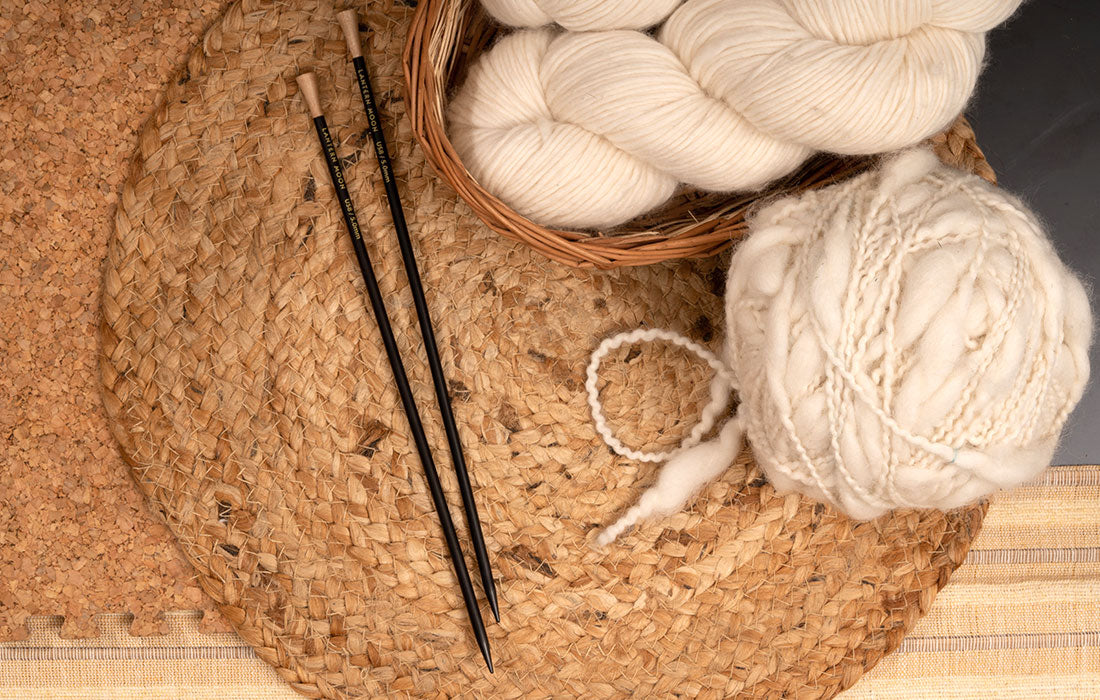
Bind off is a finishing technique used in all knitting projects. Whether it’s a small dishcloth or a large blanket, a lace knit shawl or a colorwork sweater, you’ll always need to bind off your stitches. It is the last step before you take your project off the knitting needles. The bind off techniques works for all patterns whether you are working with a pair of single pointed needles to knit a pattern back and forth or knitting in the round with DPNs or using the varying lengths of circular needles to knit back and forth or in the round.
There are many ways to bind off or cast off (as knitters in the UK say). Like the cast on row or round, the bind off row or round is never counted in a pattern. Also, similar to cast on, the method to bind off stitches needs to be carefully selected so that the project is neat and practical. In our previous blog, we’ve discussed how to bind off stitches in knitting, however in this blog, we’ll walk you through the three-needle bind off. An effective bind off technique as well as a seaming method, this one works as a neat and professional edge. If you want to join two separate knitted pieces together without seaming then you can easily adopt this method for all your knitting projects. An alternative to the Kitchener stitch, this stitch technique works is multiple ways. Whether you are looking to bind off, seam neatly and graft stitches, the three-needle bind off is handy. So, the next time you plan knitting the top of the socks, the top of a hat, shoulder seams or a knitted toy, work out the three-needle bind off.
Working the Three-Needle Bind Off
While you can work this bind off with any two needles of the same size, it is advised to use double-pointed knitting needles. With two pointy edges on either ends, DPNs have greater freedom to move the stitches but also greater responsibility to manage the stitches. Each needle will hold the same number of stitches while a third needle of the same size will also be used. Even if you have knit the project on circular knitting needles or even single pointed needles, switch to double-pointed needles for this particular method. This works best when you have a limited number of stitches that can be easily divided over two needle tips.
Instructions
The three-needle bind off is worked the same way as a standard bind-off. Move the stitches to two separate needles placed parallel to each other, at the same time to form a seam-like edge.
Step 1: Hold the two sets of live stitches you want to join with their right sides facing each other. Make sure that the corresponding stitches from each needle are aligned.
Step 2: Insert a third knitting needle into the first stitch on the front needle and the first stitch on the back needle, as if to knit.
Step 3: Wrap the working yarn around the third needle and knit the stitches together, creating a regular knit stitch. With this, you have bound off the first stitch.
Step 4: Repeat step 3 for the next stitch on both needles, knitting them together and binding off the second stitch.
Step 5: With your left-hand needle, lift the first stitch on the third needle over the second stitch and off the needle, just as you would for a regular bind off.
Repeat steps 2-5 until one stitch remains on the third needle.
Cut the working yarn, leaving a tail of a few inches to weave in. Thread the tail through the last stitch and pull it tightly to secure.
Weave in any remaining yarn tails with the right size of your finishing needles.
The result is a clean and secure seam that joins the two sets of live stitches together. The three-needle bind off creates a visible ridge on the right side of the work, so keep that in mind when deciding where to use it in your project. It's a great technique for creating a professional finish without the need for additional seaming or sewing.
More Uses for the Three-Needle Bind Off
Neat bind off, grafting or seaming, the three-needle bind-off is great in many ways. Because this technique is quite strong and can hold the weight of the garment without sagging this works for shoulder seams. For patterns such as a cowl, scarf or headband that requires joining two pieces of knitting together at the center, this has a neat edge. Whenever you are starting with provisional cast-on, in that case, when those stitches are made “live” you can work a 3 needle bind off.
Tips for a Neat Three-Needle Bind Off
- Watch your tension. It is important to use the correct tension when you bind off your stitches. Too tight stitches may result in puckering while letting it too loose, it will produce a sloppy-looking seam. If you have problems maintaining a loose tension, try using a knitting needle size larger than the original needle size used for the pattern.
- Have equal number of stitches on both needles. This bind-off technique requires that each stitch has a match. Count the stitches on both needles before you begin.
- Try a crochet hook. If you do not have the third needle of the same size, work with a crochet hook of the same size or one or two size bigger. Use the crochet hook the same way as a knitting needle going through the stitches on both needles.
So, get started on making bind offs with three needles.
For all your craft needs, look no further than the Lantern Moon collection for premium knitting needles. Handcrafted by skilled artisans, these needles truly reflect superior craftsmanship. Made from prized ebony wood, each needle has a velvety finish that feels incredibly smooth in the hands of the maker. Whether you are a beginner or an experienced knitter, these high-quality tools and accessories will enhance your knitting experience and help bring your creative visions to life. Explore our collection today and let your creativity soar with Lantern Moon ebony wood knitting needles.